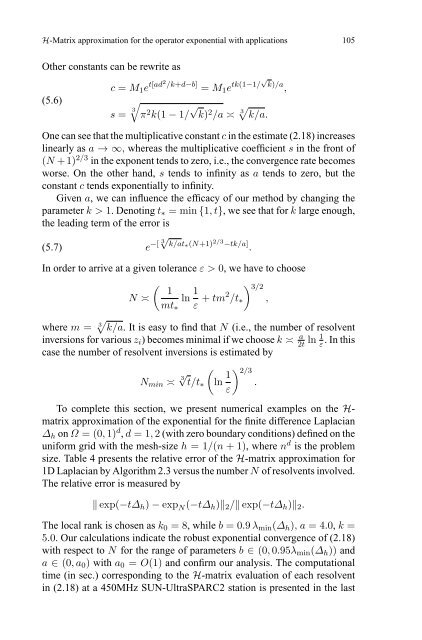H-Matrix approximation for the operator exponential with applications
H-Matrix approximation for the operator exponential with applications
H-Matrix approximation for the operator exponential with applications
You also want an ePaper? Increase the reach of your titles
YUMPU automatically turns print PDFs into web optimized ePapers that Google loves.
H-<strong>Matrix</strong> <strong>approximation</strong> <strong>for</strong> <strong>the</strong> <strong>operator</strong> <strong>exponential</strong> <strong>with</strong> <strong>applications</strong> 105<br />
O<strong>the</strong>r constants can be rewrite as<br />
(5.6)<br />
c = M 1 e t[ad2 /k+d−b] = M 1 e tk(1−1/√ k)/a ,<br />
s = 3 √π 2 k(1 − 1/ √ k) 2 /a ≍ 3√ k/a.<br />
One can see that <strong>the</strong> multiplicative constant c in <strong>the</strong> estimate (2.18) increases<br />
linearly as a →∞, whereas <strong>the</strong> multiplicative coefficient s in <strong>the</strong> front of<br />
(N +1) 2/3 in <strong>the</strong> exponent tends to zero, i.e., <strong>the</strong> convergence rate becomes<br />
worse. On <strong>the</strong> o<strong>the</strong>r hand, s tends to infinity as a tends to zero, but <strong>the</strong><br />
constant c tends <strong>exponential</strong>ly to infinity.<br />
Given a, we can influence <strong>the</strong> efficacy of our method by changing <strong>the</strong><br />
parameter k>1. Denoting t ∗ = min {1,t}, we see that <strong>for</strong> k large enough,<br />
<strong>the</strong> leading term of <strong>the</strong> error is<br />
(5.7) e −[ 3√ k/at ∗(N+1) 2/3 −tk/a] .<br />
In order to arrive at a given tolerance ε>0, we have to choose<br />
( 1<br />
N ≍ ln 1 ) 3/2<br />
mt ∗ ε + tm2 /t ∗ ,<br />
where m = 3√ k/a. It is easy to find that N (i.e., <strong>the</strong> number of resolvent<br />
inversions <strong>for</strong> various z i ) becomes minimal if we choose k ≍ a 2t ln 1 ε<br />
. In this<br />
case <strong>the</strong> number of resolvent inversions is estimated by<br />
N min ≍ 3√ (<br />
t/t ∗ ln 1 ) 2/3<br />
.<br />
ε<br />
To complete this section, we present numerical examples on <strong>the</strong> H-<br />
matrix <strong>approximation</strong> of <strong>the</strong> <strong>exponential</strong> <strong>for</strong> <strong>the</strong> finite difference Laplacian<br />
∆ h on Ω =(0, 1) d , d =1, 2 (<strong>with</strong>zero boundary conditions) defined on <strong>the</strong><br />
uni<strong>for</strong>m grid <strong>with</strong> <strong>the</strong> mesh-size h =1/(n +1), where n d is <strong>the</strong> problem<br />
size. Table 4 presents <strong>the</strong> relative error of <strong>the</strong> H-matrix <strong>approximation</strong> <strong>for</strong><br />
1D Laplacian by Algorithm 2.3 versus <strong>the</strong> number N of resolvents involved.<br />
The relative error is measured by<br />
‖ exp(−t∆ h ) − exp N (−t∆ h )‖ 2 /‖ exp(−t∆ h )‖ 2 .<br />
The local rank is chosen as k 0 =8, while b =0.9 λ min (∆ h ),a=4.0, k =<br />
5.0. Our calculations indicate <strong>the</strong> robust <strong>exponential</strong> convergence of (2.18)<br />
<strong>with</strong>respect to N <strong>for</strong> <strong>the</strong> range of parameters b ∈ (0, 0.95λ min (∆ h )) and<br />
a ∈ (0,a 0 ) <strong>with</strong> a 0 = O(1) and confirm our analysis. The computational<br />
time (in sec.) corresponding to <strong>the</strong> H-matrix evaluation of eachresolvent<br />
in (2.18) at a 450MHz SUN-UltraSPARC2 station is presented in <strong>the</strong> last
















